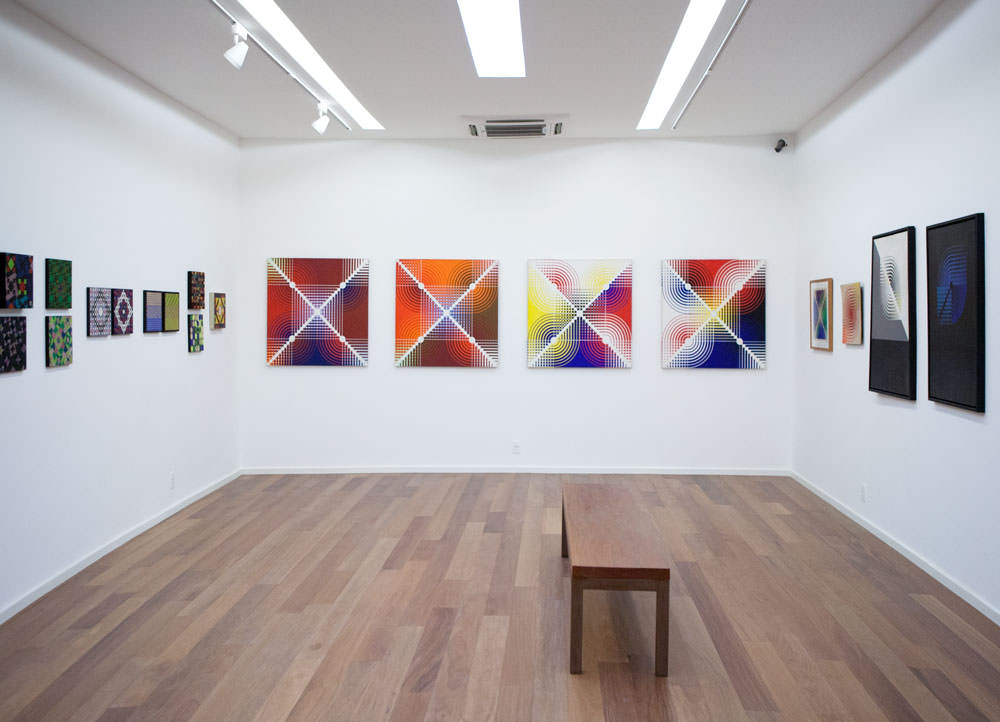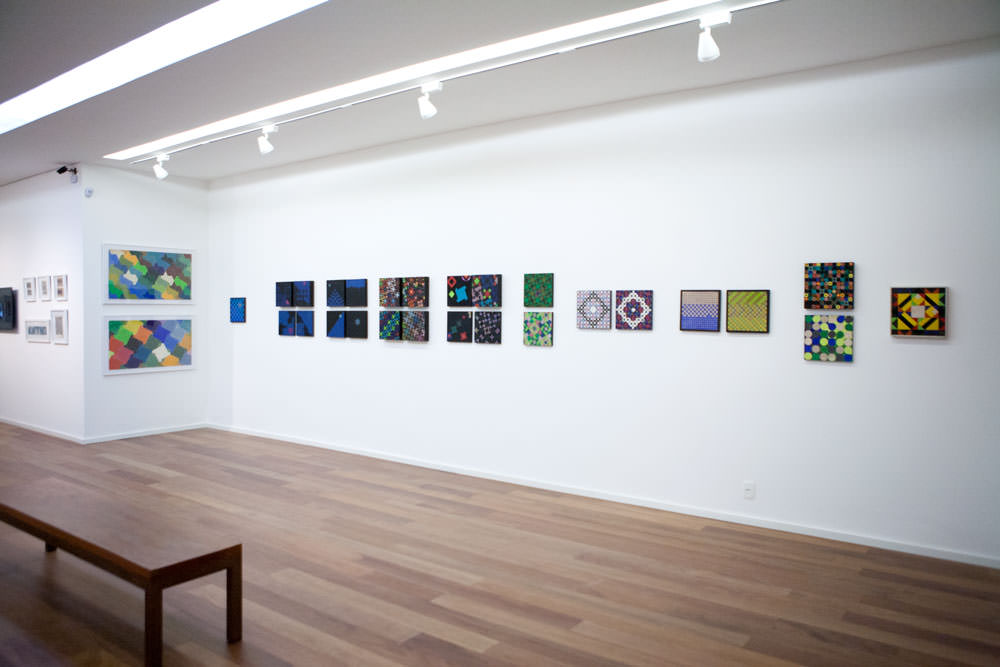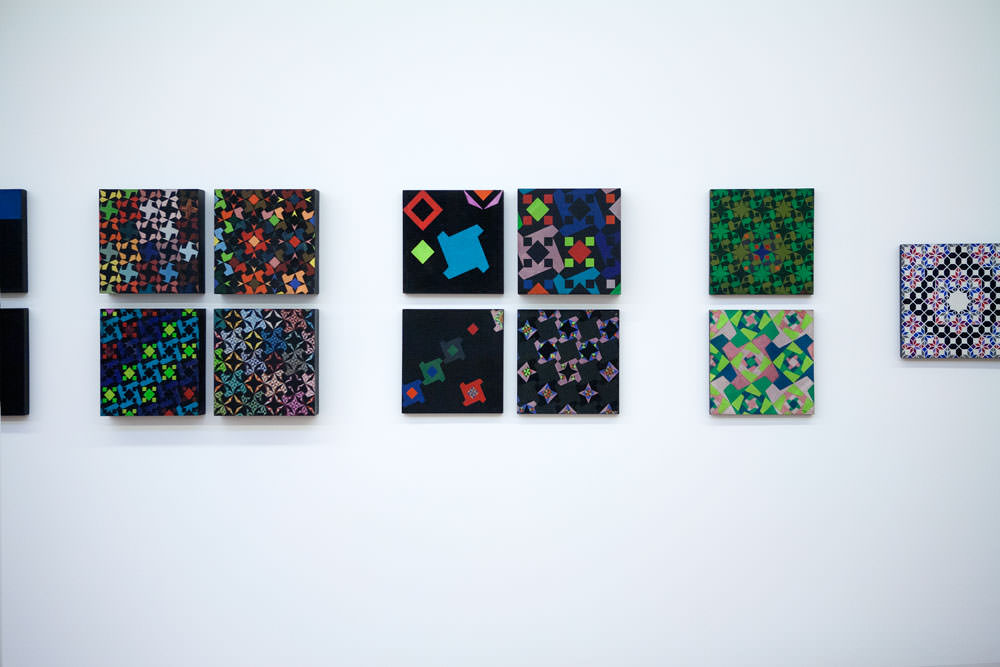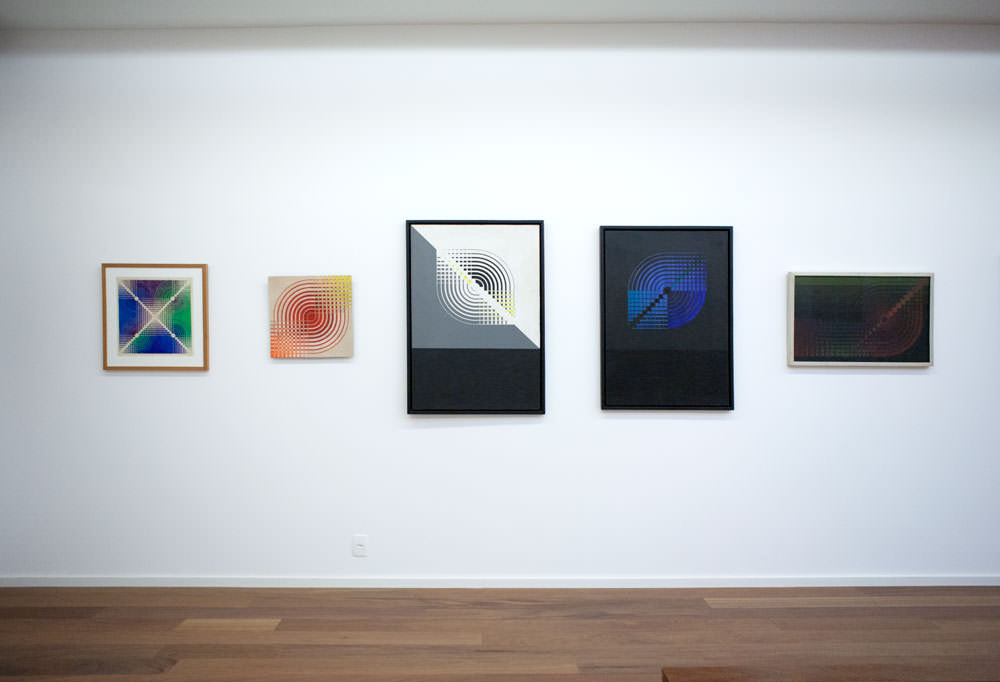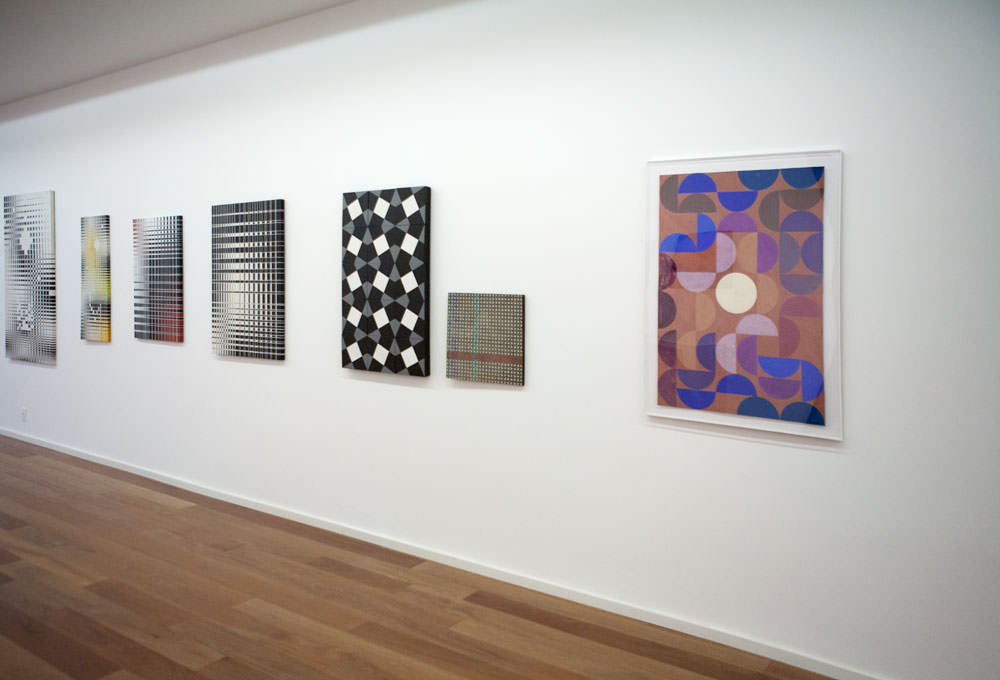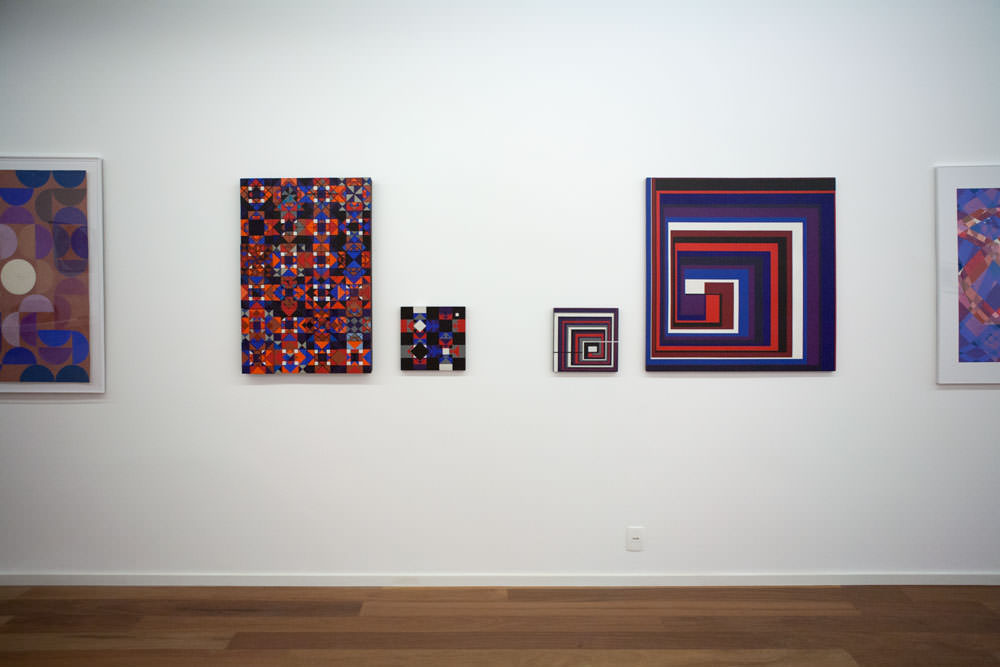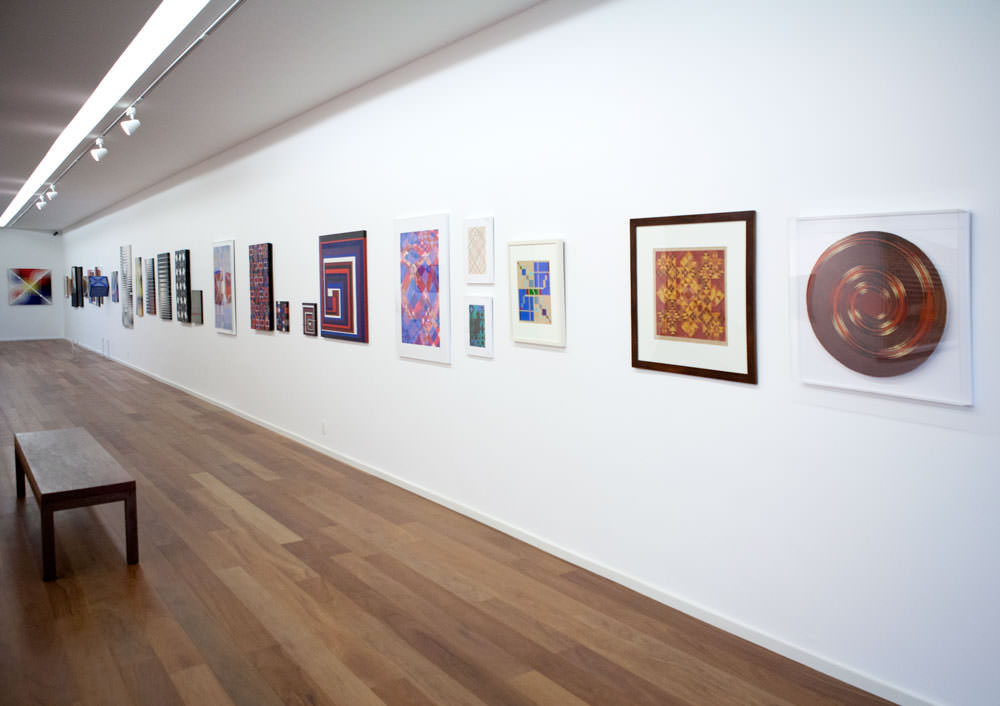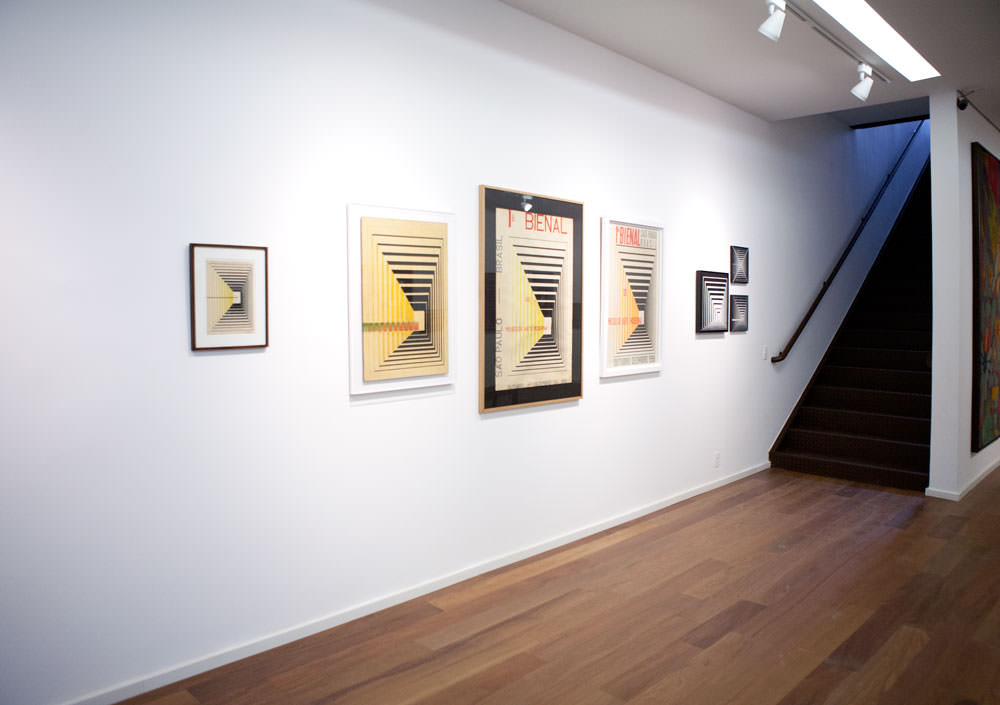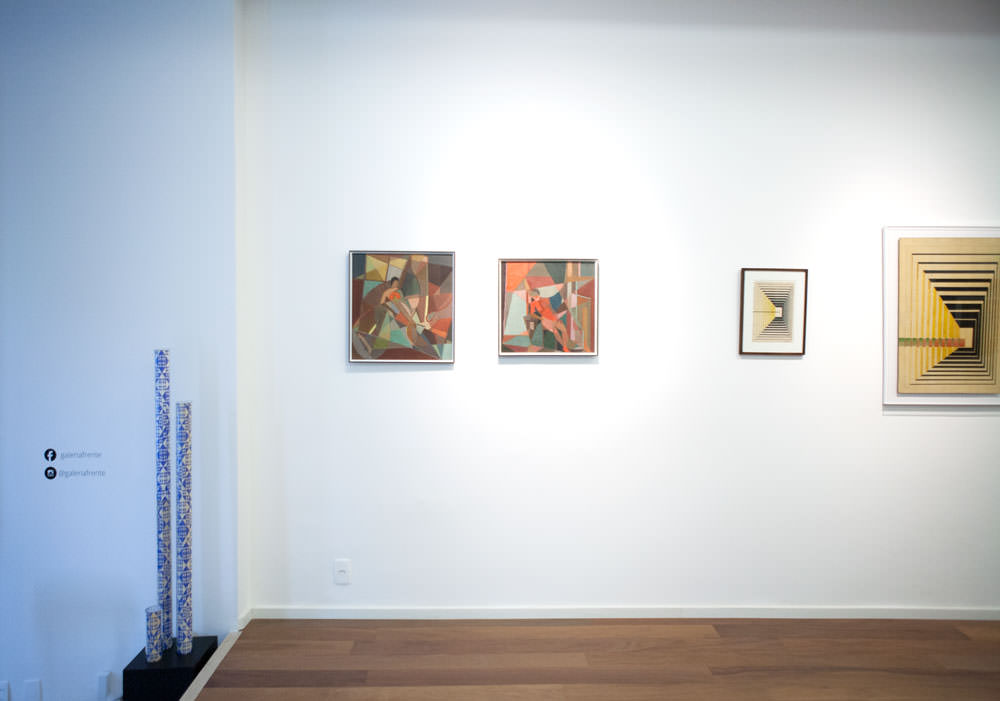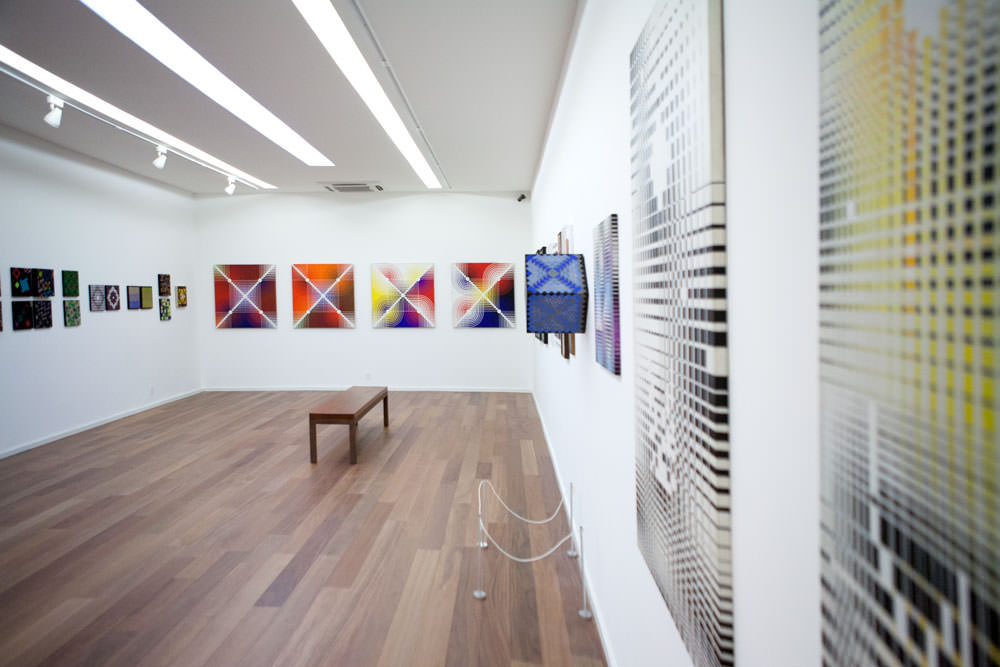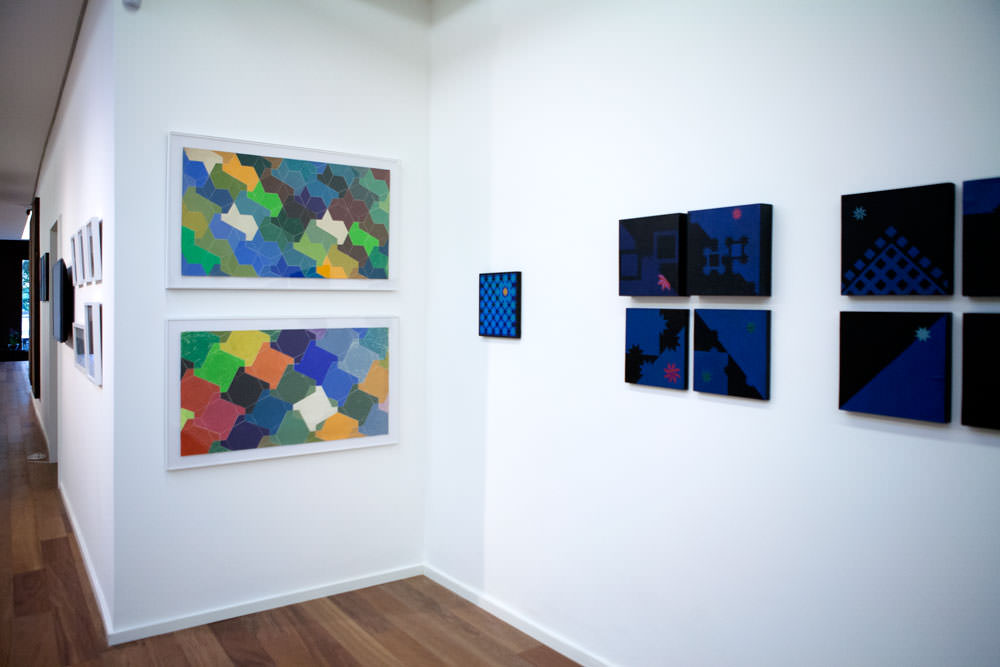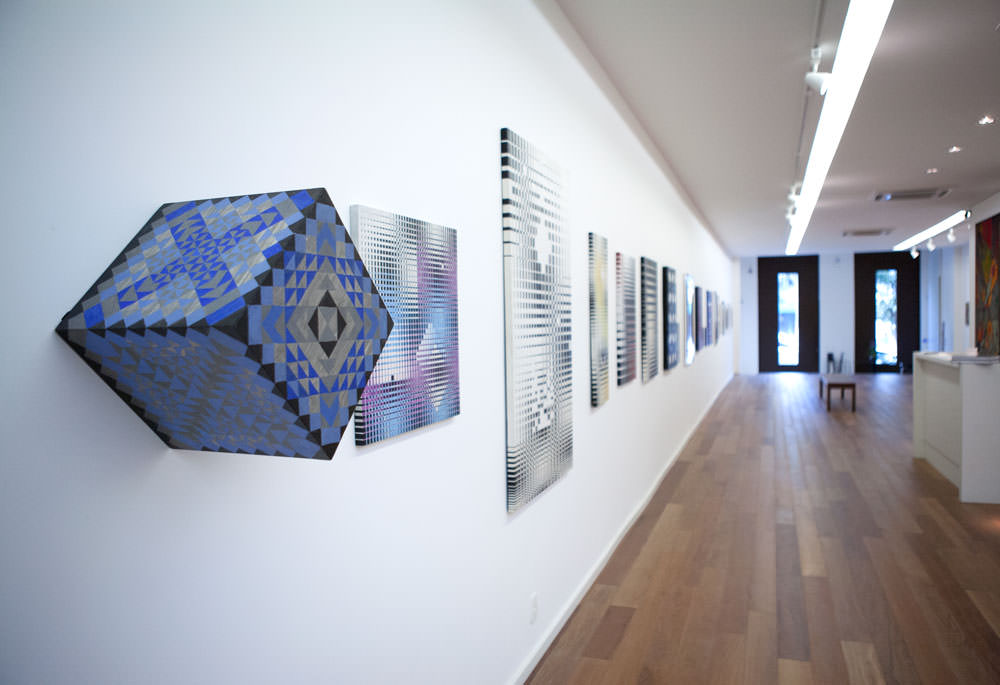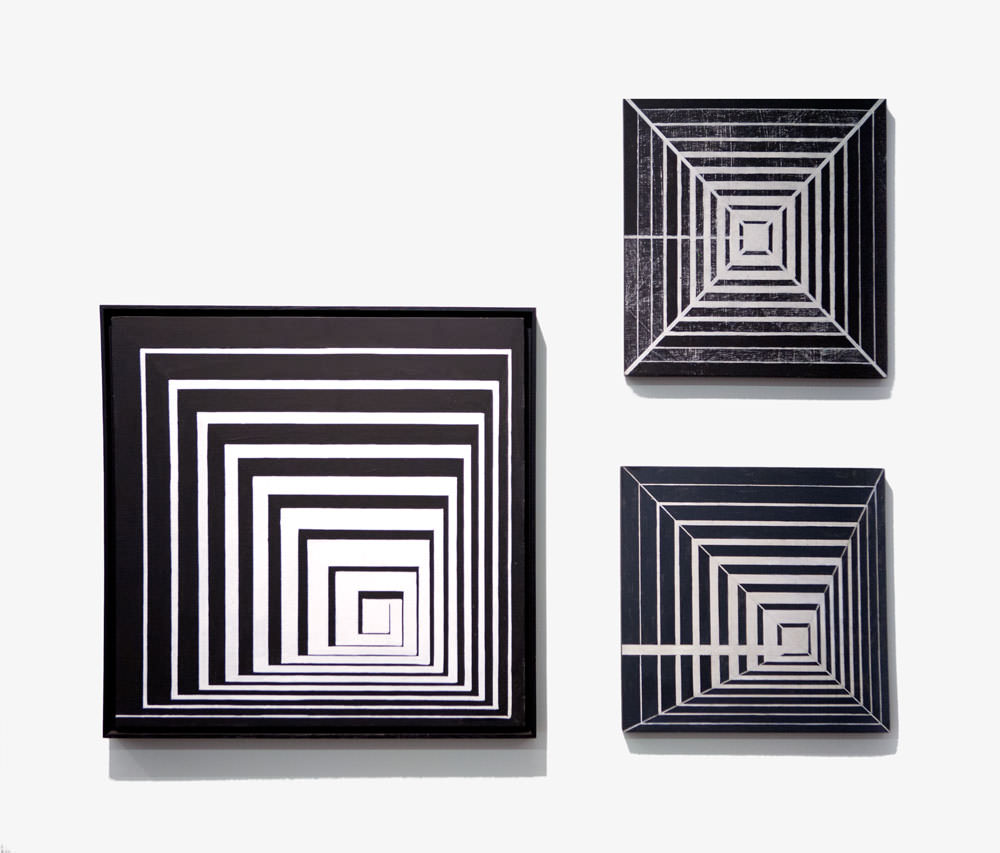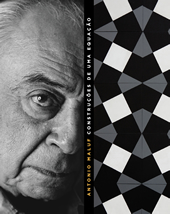Antonio Maluf
Constructions of an Equation
ANTONIO MALUF
THE ARTISTIC SCENE IN SÃO PAULO BETWEEN THE 1940s AND 1950s
At the end of the 1940s and the beginning of the 1950s, there was a great cultural effervescence in the city of São Paulo. In 1947, the São Paulo Museum of Art was created, and the following year, the Museum of Modern Art. Both institutions provoked significant changes in the city’s artistic environment, which was rapidly transforming into a metropolis. Other initiatives, such as the creation of the Brazilian Comedy Theater (1948) and the Vera Cruz Cinematographic Company (1949), further enriched São Paulo’s cultural life. The growing industry and the strength of the coffee economy financed these actions. Amid the excitement of those years, a generation of artists emerged that opposed modernist complacency, among them Antonio Maluf, in search of new visual languages compatible with the increasing industrialization and rapid transformation of the city of São Paulo. The dynamics of the new museums and the creation of the São Paulo Biennial helped synchronize our cultural “clock” with global artistic avant-gardes and amplified the debate regarding new aesthetic trends. Some exhibitions held in the newly inaugurated museums caused a stir and had a major impact on the cultural scene, especially those of Alexander Calder in 1948 and Max Bill in 1950, both at MASP, and the exhibition From Figurativism to Abstractionism in 1949 at MAM-SP, which intensified the debate between figuration and abstraction and contributed to the strengthening of the abstract movement among the new generation. It is worth remembering that, at the time, communists, who had a strong presence in the artistic and cultural scene, condemned abstract art. According to them, abstractionism served the interests of American imperialism. Portinari and Di Cavalcanti, for example, claiming the social denunciation function of art, became public enemies of abstraction.
However, the activities of the museums followed other criteria and helped to internationalize São Paulo’s cultural scene and open space for abstract art. Soon, MASP and MAM became meeting points for young artists. The exhibitions also had a significant impact on the general public. Official data from the time report 80,000 visitors to MASP in 1950. In these encounters, artists debated European avant-gardes and began to show interest in new themes – such as photography, design, landscaping, fashion design – that broadened the discussion about art and its function in society. Even accused of playing into Yankee imperialism, some artists of the younger generation adopted abstract art and became interested in industrial design. At that time, Gestalt concepts (a term in German meaning the unified whole) were still new to the artistic milieu, which began to discuss them after Mário Pedrosa presented in Rio de Janeiro, in 1949, his thesis “On the Affective Nature of Form in the Work of Art.” The principles of Gestalt and visual perception studies were adopted by Antonio Maluf and the constructive artists.
YEARS OF FORMATION
It was in this context – of ruptures, transformations, and cultural internationalism – that Antonio Maluf began his journey as an artist. Initially, he studied drawing, engraving, and painting with Flávio Motta, Waldemar da Costa, Nelson Nóbrega, Poty Lazarotto, Darel Valença Lins, and Aldemir Martins. Later, he attended Samson Flexor’s studio for a short period, where he produced some figurative paintings in which we can already perceive an interest in the geometric framework of spatial structure. The path to abstraction was evident in his work. Curiously, Antonio Maluf abandoned the classes shortly before Flexor created the Abstraction Studio and distanced himself from the ideas proposed by him.
According to the artist, the fundamental concepts for the development of his language were acquired in the courses taught by the Institute of Contemporary Art of MASP – IAC, especially in the classes of Zoltan Hedegus. For Maluf, the professor's materials classes were decisive: “From Hedegus's proposition, one can understand the concept of concrete art as a structure that transforms without losing its original base”¹. It was from this idea by Hegedus, presented in the industrial design course and aimed at solving design problems, that Maluf created the artistic foundations of his visual language.
THE RECLUSIVE ARTIST
Upon leaving IAC, Antonio Maluf began an independent and solitary creative process, a rare case in Brazilian contemporary art. Throughout his career, he did not join groups or aesthetic trends nor sign artistic movement manifestos. During his lifetime, by personal choice, his work was rarely exhibited. To this day, most of his production remains unpublished. He held only two solo exhibitions in his lifetime: the first at the Cosme Velho gallery in 1968, and the second at the Maria Antonia University Center in 2002, curated by Regina Teixeira de Barros. Antonio Maluf was a pioneer: he adopted the concept of concrete art before the group led by Waldemar Cordeiro published its manifesto and created Grupo Ruptura in 1952, of which he was not a member. Affable and surrounded by friends, he was communicative and, years later, during the time he directed the Seta gallery, maintained a strong presence in Brazil’s cultural life. But at the same time, he was a totally reclusive artist: he created and kept to himself everything he produced. Except for his murals made on buildings and thus highly visible, his works were rarely exhibited outside his studio. Few friends had access to his production. Nevertheless, he left a vast body of work, executed with rigor, and worked uninterruptedly until his death. Demanding in his artistic process, for five decades his production adhered to the concept of the “equation of developments.” Without deviating from his principles, he sought to expand, as far as possible, the formal and chromatic results of this constructive adventure. The principle of increasing and decreasing progressions, adopted in 1951, before the poster competition for the 1st Biennial, remained present throughout his artistic trajectory, including in his final work, begun but unfinished, a few months before his death in 2005. From the beginning, Antonio Maluf defined himself through a geometric abstraction of precision – with ruler and compass. Even so, the constructive rigor based on mathematical calculations did not prevent the creation of a rich and diversified visual universe, of continuous and endless paths, expanding and contracting, stemming from progressive developments of form and rhythmic variations with alternating colors. In his work, applied mathematics becomes poetry, and the artist proves that discipline and adherence to an equation are not obstacles to creative autonomy, just as the meter of a sonnet does not limit a poet's freedom. When we observe the principle of fugue in the musical work of Johann Sebastian Bach, we perceive a certain poetic affinity, a musical parallel with the constructive thesis adopted by Antonio Maluf in his visual compositions. In the art of the fugue, the presentation of the musical subject occurs at the beginning, with a solitary voice singing the entire fugue. Then another voice enters in sequence, singing the initial subject, and other voices resume the theme, always waiting for the previous voice to conclude before entering, following the order: bass, tenor, alto, and soprano. Antonio Maluf constructs pictorial space starting from a formal unit (the subject) and establishes increasing and decreasing progressions of the initial form (matrix). Thus, the forms that follow with progressive size variations (larger or smaller) and that repeat a structure (or structures derived from it) succeed one another or sometimes overlap. The changes in color or black/white contrast in formal developments establish “voices” that articulate and expand in space.
ANTONIO MALUF, PIONEER OF CONCRETE ART
It is interesting to note that when he created his first increasing and decreasing progressions, which resulted in the poster for the 1st Biennial, geometric abstraction was just beginning in Brazilian art. In the late 1940s, few artists followed the constructive abstraction movement. Among the pioneers were: Abraham Palatnik, Almir Mavignier, Ivan Serpa, Luiz Sacilotto, Lothar Charoux, Mary Vieira, and Waldemar Cordeiro. The 1st São Paulo Biennial of the Museum of Modern Art, opened in 1951, was the major artistic event and the first exhibition held in Brazil with international impact. That year, it marked a milestone in the history of Brazilian art. The event included the participation of 20 countries, exhibiting about 1,800 works by 729 artists, 489 of whom were foreign. The success was so great that it attracted an audience of over 50,000 visitors, an unprecedented figure at the time. Figurative art was still predominant in the 1st Biennial. Portinari and Di Cavalcanti, who were part of the exhibition, attacked abstractionism as alienated art, and there was a strong movement against abstraction led by leftist intellectuals. As a result, few Brazilian artists presented abstract works that were approved by a selection jury to compose the general section of the Biennial. They were: Antonio Maluf, Abraham Palatnik, Almir Mavignier, Antonio Bandeira, Casimiro (Kazmer) Féger, Gastone Novelli, Geraldo de Barros, Ivan Serpa, Lothar Charoux, Waldemar Cordeiro, and Luiz Sacilotto, most of them with a geometric, constructive tendency.
Antonio Maluf won the poster competition for the major event, that is, he created the promotional image of the 1st Biennial and emerged as a vanguard artist. The jury for the competition included the artist and printmaker Lívio Abramo, the art critic Mário Pedrosa, and the architect Rino Levi. Maluf also participated with a work in the general section of the 1st Biennial, reserved for artists of various nationalities who were subject to a selection jury. The work chosen for the general section of the Biennial was “Equation of Developments,” created in gouache on paper, now part of the Patricia Phelps de Cisneros Foundation collection (Caracas, Venezuela). Both the poster and the gouache presented at the 1st Biennial were created by applying the concept of increasing and decreasing progressions.
The constructive expression was already manifesting among some artists from São Paulo and Rio de Janeiro, but it was from the 1st Biennial of the Museum of Modern Art that the trend gained prominence in Brazilian art. In a way, we can say that the Biennial strengthened the concretist movements of São Paulo and Rio de Janeiro by awarding the poster by Antonio Maluf, the painting by Ivan Serpa, and the “Cinechromatic Device” by Abraham Palatnik, as well as presenting several abstract-geometric artists in international representations, such as Sophie Tauber-Arp, Richard Paul Lohse, Hans Uhlmann, among others, and by awarding the sculpture “Tripartite Unit” by the Swiss artist Max Bill. Unknown until then as a visual artist, Antonio Maluf was a beginner when he was revealed by the award at the 1st Biennial. The poster had enormous impact on his artistic career and marked his definitive entry into the history of Brazilian art. The poster, according to Maluf, “was made of structural elements that reiterate the rectangular shape of the support.” For the artist, “the 1st Biennial poster was very important in disseminating concrete art because its function was twofold: it not only announced (the event) but also announced a whole process in which the support became the problem. In the poster, nothing was being transported; it said: ‘this is me, a rectangle.’ This homage to the rectangle anticipates by at least a decade other homages to geometric shapes.”²
Today, the 1st Biennial poster is an anthology landmark of Brazilian graphic design, an icon of geometric abstraction and concretism in Brazil. In those years, concrete artists sought a broader definition of art as product. There was interest in expanding it to industrial design, graphic design, and advertising. They intended to integrate artistic activity into contemporary industrial production, that is, they wanted to place art into everyday urban life. Antonio Maluf was one of the first artists to embrace this concept. He was already working as a graphic designer, developing prints for the textile industry owned by his family. Later, he established connections with architecture and created graphic works for advertising. Other concretists also worked in design and advertising: Waldemar Cordeiro was an advertiser, illustrator, and landscaper; Geraldo de Barros was a photographer and industrial designer; Luiz Sacilotto was a technical draftsman. After the excitement of the 1st Biennial, Antonio Maluf was invited by Mário Pedrosa to participate in the 1st National Exhibition of Abstract Art, held at the Quitandinha Hotel in Petrópolis (RJ), which opened in February 1953, with the presence of several politicians, including Juscelino Kubitschek, then governor of Minas Gerais. Maluf was the only São Paulo artist at the Quitandinha Hotel exhibition and presented a tempera on cardboard titled “Increasing and Decreasing Color Progressions,” created in 1951. Mário Pedrosa, in an article published in the press about the exhibition, drew attention to the color modulation in increasing and decreasing sequences by the young artist.
For Antonio Maluf, the sequences occur due to the “equation of developments.” According to the artist, the relationship of equivalence that integrates language elements with the support also transforms the support into an element of language, that is, the image and the support are integrated and both are signifiers. For him, it is in this process that visual information is established and must be carried out through the intervention of forms integrated with and referring to the support. The artist uses systems of clear principles, works with mathematical sequences to produce constants, and through them, builds space. In his view, in concrete art, structures transform without losing their original base. In the text for the catalog of Maluf’s exhibition held at the Maria Antonia University Center, USP, Regina Teixeira de Barros states that the concept of the “equation of developments” guided all of his production from the 1950s until his death. According to her, “an equation is understood as a relationship of equality that occurs between the elements of language and the support on which these elements are applied. This relationship acquires the status of artistic information only when the language has no other point of reference than the support itself, and vice versa. That is, the elements of language and the support cease to signify independently to create a relationship of absolute complicity. This identification between the two distinct categories becomes concrete artistic information.”
PUBLIC ART
In 1960, Antonio Maluf met the architect Fábio Penteado, with whom he established a friendship and lasting partnership. Invited by the architect to create a panel for the Brigadeiro Building, the artist faced the challenge of working with his mathematical sequences on large scales and in the open space of the city. This relationship with architecture opened new paths for his artistic expression and led to a curious fact – the recluse who did not show his work to anyone was now exhibiting his work in the public space, visible to thousands of people in the hectic daily life of São Paulo.
Soon came numerous invitations to develop panel projects in partnership with other architects, without losing his connection with Fábio Penteado. In the 1960s, Antonio Maluf focused primarily on developing these projects. Today, in his body of work, we find several studies, sketches, and notes to guide the production of murals, including those that were not built. Some drawings contain mathematical calculations and color scales in the margins to indicate the panel assembly.
Architect Lauro da Costa Lima, with whom he had already created a mural for the Cambuí Building in the Higienópolis neighborhood, invited him to execute a large panel for two blocks of the Vila Normanda Building. The panel planned in the project had about 1,000 square meters of area and was built in 1964. Maluf decided to carry it out using glazed ceramic tiles of a single format, 30 x 15 centimeters. Each tile was a module, a rectangular formal unit, based on his work “Subdivisions of a Rectangle Around the Orthogonal and Diagonal Axes,” created by the artist in 1958.
“Through three silk-screen matrices, 12 possible unit codes were defined. The articulation of these 12 codes with each other, on the four sides of the tile, allowed the continuation of a new unit of 192 codes that made it possible to cover the desired area in a non-repetitive way,” explains Maluf.
In another statement, the artist affirms that his goal was to create a structure with no beginning or end.The studies of structures for panels were later used in a series of patterned products, mainly for the textile industry. For the artist, “when a structure is obtained, it begins to be unfolded into everything that can be used with it in the field of industrial products.” Thus, in the print he called “Introduction to Alphabetical Language,” the artist used the same infinite structure as the mural made for the Cambuí Building: “I used it in the fabric print and also made a bricolage with alphabet letters. This way I used such structures as possibilities of product as they emerged”³. Antonio Maluf's work followed a straight path, without highs or lows, without decline. Although he created a system of formal and chromatic articulation, the results were always innovative. By establishing new articulations, he also generated different paths, ad infinitum, that had the capacity to surprise us with the richness of limitless possible variations. Despite the concretist rigor, Maluf was not indifferent to the strength of the new figuration that emerged in the 1960s, called by Mário Schenberg “new objectivity.” Several artists of the concretist movement abandoned abstraction and adopted new figuration, such as Ivan Serpa, Maurício Nogueira Lima, Geraldo de Barros, and even Waldemar Cordeiro. During that period, Maluf also introduced figurative elements into some of his works. However, even in those works, the structural logic remained concrete.
The exhibition “Antonio Maluf – Constructions of an Equation,” organized by Galeria Frente with the support of Antonio Maluf’s family, presents the artist in full. It displays a set of works never before assembled. A total of 140 works were selected using various techniques that encompass all periods of his production, from the first figurative paintings created during his training period in the 1940s to works from the final period in the early 21st century, including the last work Antonio Maluf left unfinished when he died in August 2005.
1. MALUF, Antonio. “The concept of concrete art, based on my work.” Unpublished text belonging to the artist's family archives.
2. Statement belonging to the artist's family archive3. Unpublished statement belonging to the artist's family archive.
By Fabio Magalhães
